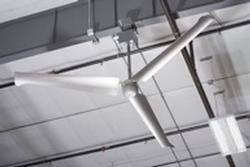
Rite-Hite™ offers HVLS Fans with direct drive technology
New direct drive high-volume, low-speed (HVLS) fans from Rite-Hite deliver the climate-control benefits of traditional HVLS fans with added benefits of direct drive motor technology.
“The direct drive motor eliminates the need for a gearbox and offers significant advantages to facilities operating in a variety of industries,” said Andy Olson, Rite-Hite Fans Director of Marketing. “Commercial and retail stores appreciate the virtually silent motor, and with the absence of oil, direct drive HVLS fans are ideal for food and pharmaceutical processing facilities.”
Rite-Hite has added two direct drive fan models to their current HVLS fan offering. The Revolution® 75 Series is available in 8- to 24-foot diameters and ideal for larger, industrial spaces. The Revolution® 25 Series is available in 6- to 12-foot diameters and incorporates a sleek blade design which is appealing to commercial and retail environments. The direct drive fans come standard with the Fan-Commander® 2.0 Touchscreen Control, a wireless station with 7-day customizable scheduling for up to 24 fans. Controls can be accessed through a building management system or remotely from a PC or mobile device with standard Ethernet connectivity. Optional sensors can adjust fan operation based on ambient temperatures.
Fans were designed with simplicity and safety in mind. They are shipped pre-wired and factory configured for each application which helps reduce installation costs and time, and the wireless control station allows cooling to begin almost immediately. Redundant safety features are integrated into all direct drive HVLS fan designs.
A single direct drive HVLS fan circulates large volumes of air, up to 85 feet from the fan’s center in all directions and can cover up to 22,000 square feet. The fan’s unique design directs air downward from the center in a conical shape creating uniform airflow from floor to ceiling and from wall to wall. Direct drive HVLS fans reduce moisture build-up on surfaces, improve overall indoor air quality, and help boost productivity by reducing effective temperatures for workers.









